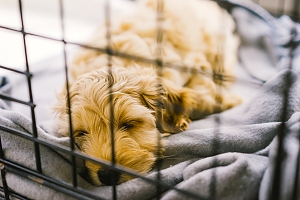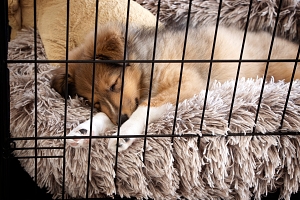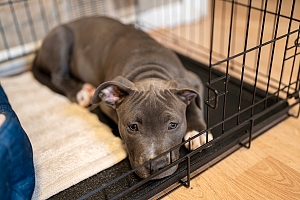Embracing the concept of crate training for puppies and dogs can be a transformative journey for both pets and their owners. It’s more than just a containment method; it’s a sanctuary where your furry companion can find solace, security, and even joy.
Let’s delve deeper into the nuances of crate training, exploring its multifaceted benefits and unraveling the strategies to make this experience enriching for your pet.
Understanding the Purpose of Crate Training
 The rationale behind crate training spans a spectrum of objectives. Firstly, it serves as a pivotal tool in housebreaking, providing a structured environment where puppies and dogs can learn proper elimination habits.
The rationale behind crate training spans a spectrum of objectives. Firstly, it serves as a pivotal tool in housebreaking, providing a structured environment where puppies and dogs can learn proper elimination habits.
Moreover, crates act as a safe haven, offering refuge from external stimuli and mitigating behavioral issues such as excessive chewing or property destruction. Whether you’re embarking on a journey or navigating daily routines, a well-trained dog in a crate ensures a smoother, safer experience for both pet and owner.
Embracing Positive Reinforcement
Central to successful crate training is the application of positive reinforcement techniques. Rather than viewing the crate as a punitive measure, it should be portrayed as a haven of comfort and security. Avoid using the crate as a form of punishment, as this may instill fear or exacerbate existing anxiety in your pet.
Instead, focus on creating positive associations by incorporating rewards and praise into the training regimen. By reinforcing desirable behaviors, such as voluntarily entering the crate, you cultivate a harmonious bond built on trust and mutual understanding.
Selecting the Perfect Crate
When choosing a crate for your canine companion, meticulous consideration should be given to size, comfort, and functionality. Opt for a crate that accommodates your pet’s breed and size, allowing ample room for movement and comfort.
Remember, the ideal crate should offer sufficient space for your dog to stand, turn around, and stretch comfortably without feeling confined. Additionally, prioritize durability and safety features to ensure a secure and resilient enclosure for your furry friend.
Crafting a Comfortable Environment
 Transforming the crate into a cozy retreat requires thoughtful curation of its interior. Personalize the bedding to suit your pet’s preferences and habits, whether they favor soft blankets or plush pillows. Introduce familiar scents, such as items imbued with your scent, to instill a sense of familiarity and comfort.
Transforming the crate into a cozy retreat requires thoughtful curation of its interior. Personalize the bedding to suit your pet’s preferences and habits, whether they favor soft blankets or plush pillows. Introduce familiar scents, such as items imbued with your scent, to instill a sense of familiarity and comfort.
However, exercise caution to prevent potential hazards, particularly if your pet is prone to chewing or ingesting foreign objects. Regular monitoring and adjustments are essential to maintain a safe and inviting space within the crate.
Addressing Crate Anxiety
Crate anxiety can pose a significant obstacle in the training process, requiring patience and sensitivity to overcome. Be attuned to signs of distress, such as excessive vocalization, pacing, or trembling, and adjust the training approach accordingly. Gradually acclimate your pet to the crate through incremental exposure, pairing each interaction with positive reinforcement and reassurance.
Avoid prolonged confinement or forceful imposition, as this may exacerbate anxiety and undermine progress. Seek guidance from veterinary professionals or certified trainers to devise strategies for managing crate anxiety effectively.
Navigating House and Crate Training
Integrating crate training into housebreaking endeavors demands consistency, vigilance, and empathy. Leverage positive reinforcement techniques to reinforce desirable behaviors, such as eliminating outdoors or settling calmly in the crate. Maintain a structured routine, offering frequent opportunities for bathroom breaks and supervised outings.
Anticipate your pet’s needs and provide timely guidance, minimizing the likelihood of accidents or setbacks. With patience and persistence, you’ll foster a seamless transition towards responsible and reliable behavior.
Mitigating Potential Challenges
While crate training offers myriad benefits, it’s not immune to challenges or setbacks. Be prepared to address common issues, such as nocturnal vocalization or separation anxiety, with compassion and resilience.
Distinguish between genuine distress and attention-seeking behavior, responding accordingly to alleviate discomfort and reinforce positive associations with the crate. Consult with professionals for personalized guidance and support, customizing interventions to suit your pet’s unique needs and circumstances.
Unlocking the Rewards of Crate Training
 At its core, crate training cultivates a sense of security, autonomy, and well-being for your pet. By providing a designated sanctuary within the home, you empower your furry companion to navigate daily routines with confidence and composure.
At its core, crate training cultivates a sense of security, autonomy, and well-being for your pet. By providing a designated sanctuary within the home, you empower your furry companion to navigate daily routines with confidence and composure.
Embrace the journey of crate training as a collaborative endeavor, rooted in mutual trust, understanding, and unconditional love. With dedication and compassion, you’ll witness firsthand the transformative impact of crate training on your puppy’s growth and development.
Reach Out to Northern Virginia’s Top Puppy Sitters
Ready to give your puppy the best care while you’re away? Choose Paw Pals Pet Sitting for trusted puppy sitting services. Contact us today to ensure your furry friend receives the love and attention they deserve!


